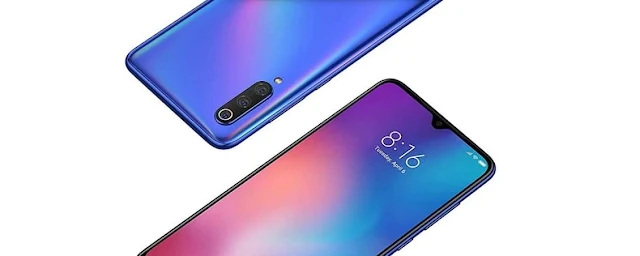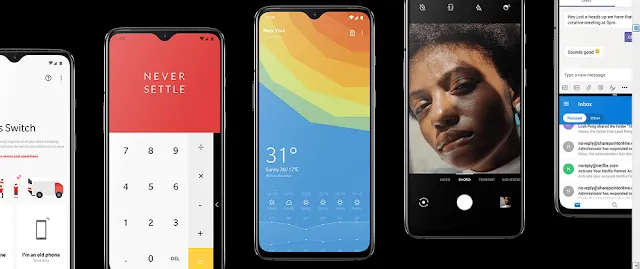A comprehensive comparison between my phone OnePlus 7 and Xiaomi Mi 9
With the beginning of 2019, competition has intensified in the smart phone market , as many companies have launched their latest phones, which come with superb specifications, strong performance, and support many new features to compete strongly in the market.
Excelled (company One Plus ) OnePlus on most of the manufacturers of Android phones so far, her lost featured ( One Plus 7 Pro ) OnePlus 7 Pro, which offers the user all he needs strong specifications, and new features, in order to work and play, and comes after the other phone OnePlus 7, which still retains the design of the OnePlus 6T, but features some new features, making it a great choice in 2019.
Xiaomi also showed that it can pose a strong challenge with its premium phone, the Xiaomi Mi 9, which combines superior performance with the right price.
A comprehensive comparison between my phone OnePlus 7 and Xiaomi Mi 9:
the design:
The two phones are similar in design; both are made of glass, curved smoothly from the back, to meet the metal frame that comes in the color of the structure.
On the other hand, the OnePlus 7 still retains the same OnePlus 6T design, but with the introduction of a new device every six months, this is not bad, as the design is sleek, keeping pace with the new designs of 2019.
While Shawy was more aesthetically pleasing, using a reflective color scheme that provides gradient colors, with a triangular head camera. The Mi series always features vibrant designs, and with the Mi 9 phone, Shawy shows that she can design a phone that looks similar to the latest Samsung and Huawei phones.
On the front you will not be able to show any difference between the two phones. Both have a small circular bump at the top of the screen with the front camera with a small edge at the bottom of the screen. The phones also do not support the 3.5mm conventional speaker port, each with a USB-C charging port , And connect the speakers.
In fact, the curves and aesthetic features of the design are almost identical in both phones. If you remove the rear camera cover and the manufacturer's logo on both phones, you will find it difficult to distinguish between them.
the screen:
The OnePlus 7 comes with an Optic AMOLED screen, measuring 6.41 inches, with a resolution of 2340 x 1080 pixels, and 402 pixels per inch.
While the Xiaomi Mi 9 comes with an Samsung AMOLED screen of 6.39 inches and a resolution of 2340 x 1080 pixels, at 403 pixels per inch.
The two phones share a Gorilla 6 layer on the screen to protect against scratches and bumps, and support for HDR10 + technology that gives you a high-quality cinematic entertainment experience, each with a fingerprint sensor integrated into the screen.
the performance:
The two phones are similar in performance, working on the same processor, the Snapdragon 855 from Qualcomm; the eight-core, 2.84 GHz, 7nm processor, delivering 45% higher performance than the previous Snapdragon 845, Artificial intelligence is three times stronger, with better energy efficiency.
The two phones also share RAM options that are available with a capacity of 6 or 8 GB, and do not support the addition of external memory cards.
The difference between the two phones here is the type, and internal storage options, where the OnePlus 7 has a simple feature: an internal storage area of UFS 3.0 2-LAN, while the Xiaomi Mi 9 is still based on the old UFS 2.1 type.
The OnePlus 7 comes with two internal storage options of 128 or 256 GB, and the Xiaomi Mi 9 comes with two options, but 64 or 128 GB.
Camera:
The OnePlus 7 comes with a dual-lens rear camera; basic: 48 megapixel camera, f / 1.6 lens slot, auto focus, 5 megapixel camera and f / 2.4 lens slot, with depth sensor.
The first lens came from the new Sony IMX586 sensor, 48 megapixel camera and f / 1.75 lens slot, second with 12 megapixel camera, f / 2.2 lens slot, 2x optical zoom, 16 megapixel camera, aperture f / 2.2, wide-angle Ultra Wide.
For the front camera, One Plus features a 16 megapixel camera with a f / 2.0 lens slot, supports Auto-HDR, and a 5-megapixel mono camera with f / 2.0 lens and supports HDR.
Operating System:
The two phones work on the same operating system: Android (9) Android 9.0 Pi, but each depends on the user interface of the manufacturer, and this is a difference between them, where you will find the phone OnePlus 7 depends on the interface OxygenOS 9, which is characterized by its simplicity and ease of use, In addition to supporting many customization options, it is the only operating interface that has been able to achieve the perfect balance between customization, and ease of use so far.
While my phone is based on the MIUI 10 interface, which still needs a lot of development, and there are many settings and features that take a long time to customize, but if you have used the Shawami interface before and did not pose any problem you can rely on.
the battery:
The OnePlus 7 comes with a 3700mAh battery that supports 20 watts of high-speed charging, not 30 watts like the OnePlus 7 Pro, and does not support wireless charging.
While the Chaoomi phone comes with a smaller battery capacity of 3300 mAh, but supports 20 watts of wireless charging.
| Specifications |
OnePlus 7 Phone
|
Phone Xiaomi Mi 9
|
Healer
| Snapdragon 855 from Qualcomm. |
Snapdragon 855 from Qualcomm.
|
the screen
|
6.41 inches in 2340 x 1080 pixels, Optic AMOLED, with a density of 402 pixels per inch.
|
6.39 inches in 2340 x 1080 pixels, Samsung AMOLED, 403 pixels per inch.
|
Internal storage space options
|
128 and 256 GB, UFS 3.0 type.
|
64 and 128 GB, UFS 2.1 type.
|
RAm RAM
|
6 and 8 GB.
|
6 and 8 GB.
|
Graphics card
|
.Adreno 640
|
.Adreno 640
|
Rear camera
|
Basic: 48 megapixel resolution, f / 1.6 lens slot, supports auto focus, second: 5 megapixel resolution, and f / 2.4 lens slot, with depth sensor.
|
The second lens: a 12 megapixel camera and a f / 2.2 lens slot, supports 2x optical zoom, the third with 16 megapixel resolution, and the f / 2.2 slot , Ultra Wide Angle.
|
Video shooting
|
4K resolution at 30/60 fps, or 1080 pixel resolution, at 30/60/240 fps, or 720 px resolution at 480 fps.
|
4K resolution at 30/60 fps, 1080 pixel resolution at 30/60 fps, or 720 pixel resolution at 30 frames per second.
|
| Front camera | 16 megapixel camera and f / 2.0 lens slot, supports autofocus. | Mono camera; 20 megapixel camera, f / 2.0 lens slot, supports HDR. |
Support microSD card
|
Does not support.
|
Does not support.
|
Biometric insurance features
|
The fingerprint sensor is integrated into the display.
|
The fingerprint sensor is integrated into the display.
|
Battery size
|
3700 mAh, does not support wireless charging.
|
3300 mAh, supports wireless charging.
|
3.5 mm conventional speaker port
|
Does not support.
|
Does not support.
|
Water resistance
|
Does not support.
|
Does not support.
|
Connection
|
Wi-Fi ac 2 x 2 MIMO, Bluetooth 5.0, AptX HD, NFC and A-GPS.
|
Wi-Fi ac, Bluetooth 5.0, AptX HD, NFC and A-GPS.
|
Colors available
|
Gray, Red Available in India, China only.
|
Black, violet, blue.
|
Operating System
|
Android 9.0 with user interface OxygenOS 9.
|
Android 9.0 eBay, user interface MIUI 10.
|
the weight
|
182 grams.
|
173 grams.
|
Dimensions
|
157.7 x 74.8 x 8.2 mm.
|
157.5 x 74.7 x 7.6 mm
|
price
|
$ 625 for the 64GB internal storage, and $ 688 for the 256GB internal storage.
|
$ 512 for the 64GB internal storage, and $ 588 for the 128GB internal storage.
|








